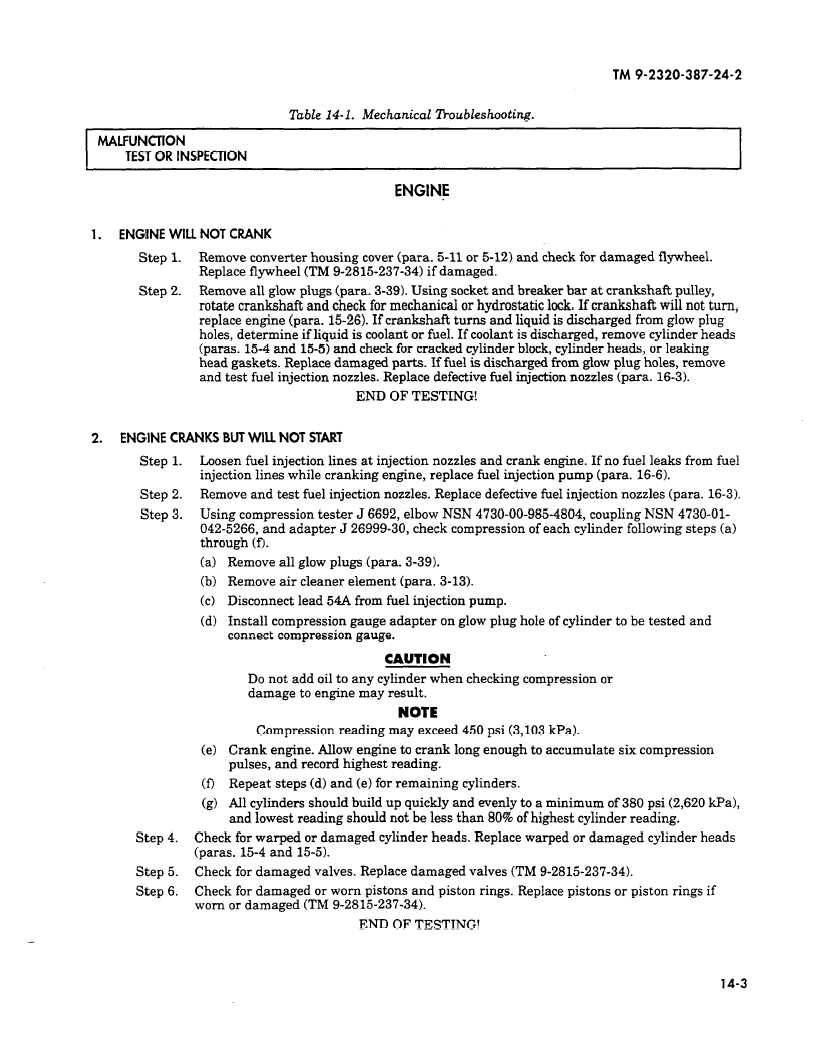TM 9-2320-387-24-2
Table 14-l.
Mechanical
l’boubleshooting.
TEST OR INSPECTION
I
ENGINE
1.
ENGINE WILL NOT CRANK
Step 1.
Remove converter housing cover (para. 5-11 or 5-12) and check for damaged flywheel.
Replace flywheel (TM 9-2815-237-34) if damaged.
Step 2.
Remove all glow plugs (para. 3-391. Using socket and breaker bar at crankshaft pulley,
rotate crankshaft and check for mechanical or hydrostatic lock. If crankshaft will not turn,
replace engine (para. 15-26). If crankshaft turns and liquid is discharged from glow plug
holes, determine if liquid is coolant or fuel. If coolant is discharged, remove cylinder heads
(paras. 15-4 and 15-5) and check for cracked cylinder block, cylinder heads, or leaking
head gaskets. Replace damaged parts. If fuel is discharged from glow plug holes, remove
and test fuel injection nozzles. Replace defective fuel injection nozzles (para. 16-3).
END OF TESTING!
2.
ENGINE CRANKS BUT WILL NOT START
Step 1.
Loosen fuel injection lines at injection nozzles and crank engine. If no fuel leaks from fuel
injection lines while cranking engine, replace fuel injection pump (para. 16-6).
Step 2.
Remove and test fuel injection nozzles. Replace defective fuel injection nozzles (para. 16-3).
Step 3.
Using compression tester J 6692, elbow NSN 4730-00-985-4804, coupling NSN 4730-01-
042-5266, and adapter J 26999-30, check compression of each cylinder following steps (a>
through (0.
(a)
(b)
(c)
(d)
(e)
(0
(g)
Remove all glow plugs (para. 3-39).
Remove air cleaner element (para. 3-13).
Disconnect lead 54A from fuel injection pump.
Install compression gauge adapter on glow plug hole of cylinder to be tested and
connect compression gauge.
CAUTION
Do not add oil to any cylinder when checking compression or
damage to engine may result.
NOTE
Compression reading may exceed 450 psi (3,103 kPa).
Crank engine. Allow engine to crank long enough to accumulate six compression
pulses, and record highest reading.
Repeat steps (d) and (e) for remaining cylinders.
All cylinders should build up quickly and evenly to a minimum of 380 psi (2,620 kPa),
and lowest reading should not be less than 80% of highest cylinder reading.
Step 4.
Check for warped or damaged cylinder heads. Replace warped or damaged cylinder heads
(paras. 15-4 and 15-5).
Step 5.
Check for damaged valves. Replace damaged valves (TM 9-2815-237-34).
Step 6.
Check for damaged or worn pistons and piston rings. Replace pistons or piston rings if
worn or damaged (TM 9-2815-237-34).
END OF TESTING!
14-3

